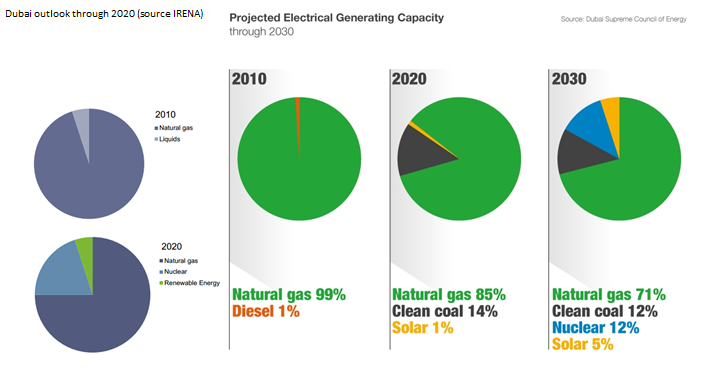This article provides an analysis of the UAE Energy mix targets for 2013. The UAE set a target to achieve for Abu Dhabi 7% renewable energy capacity by 2020 (1500 MW) and Dubai is out on a course to achieve 5% Sustainable energy by 2030 (IRENA, Directorate of Energy and Climate Change, UAE).
Fig 1: A comparison for outlooks from IRENA (The Internationals Renewable Energy Agency) and Dubai Supreme Counsel of Energy in The Business Year. We can already see that the projections of the energy mix differ a bit in their outlook.
Differences in the Nuclear part of the energy mix are visible in the projected part in 2020 in the IRENA picture compared to the Counsel picture in 2020. Combining the pictures, UAE will most likely reach a 12% proportion of Nuclear Energy between 2020 and 2030.
Regarding the renewables mix, currently projects worth of about 1 billion USD are under execution (Article).This portfolio of investments includes the following projects in Abu Dhabi by 2030:
– 100 MW CSP plant (SHAMS project)
– 100 MW PV plant (Nour I project)
– 28.8 MW wind plant approved (Sir Bani Yas project)
– 100 MW waste-to-energy plant (TAQA Waste to Energy)
The following projects are under way for Dubai by 2030
– 1000 MW Mohammad Bin Rashid Al Maktoum Solar Park
The trend is obviously moving into a sustainable direction. When we take a look at the energy consumption trend in the UAE we see that this is growing annually. A major factor explaining the consumption growth is the growth in population size in the UAE. We see that the Electricity consumption grew by (71 b kWh – 64 b kWh) / (64 b kWh) = 11% over 5 years. Roughly extrapolating over 15 years to 2030 (assuming continuing population growth, assuming other electricity use like electric cars as none), this means that UAE will face another 30% increase on electricity use.
Fig 2: Electricity consumption total for UAE per year
This 30% seems to coincide with the plans of UAE government and Energy Counsel to aim for 30% DSM (Demand side management, or effectively demand side reduction as meant in this context). This will be done by Energy Service Company structures (Esco’s) which aim at energy reduction rather than installing additional capacity. Of course this capacity can actually be built as part of the Esco’s; for example in the form of solar panels on the rooftop of an integrated building design.
If this reduction is attained then for now we will assume that energy use in UAE will be more or less equal to current electricity use.
The sustainable projects/parks listed here will generate combined ca. 1330 MW. In a year this is 1330 x 8760 hours = 11,7 million MWh = 11,7 billion kWh. Effectively this means that the Abu Dhabi capacity part of power generation out of sustainables will be in the order of 71/11,7 = 6 % of UAE electricity delivery total. Concluding: if the projects which are all planned in and executed correctly, and the goal set for DSM is reached, the UAE are well underway to meet their energy goals of 2030.
Note that the averagely delivered power output will be substantially lower than the capacity. Taking into account capacity factors for photovoltaic ranging from 15-20% (Massachusetts/Arizona) and CSP from 30-60% (California/Spain), and biomass of about 34 % (EIA 2009) then we arrive on an averagely delivered power output of about 2 billion kWh in 2030.
For a further assessment more recent numbers and trends in the electricity usage growth are necessary. Also more detailed information on all the sustainable programs in the UAE including a likelihood assessment on sustainable projects. Other than that, a number of oversimplified assumptions are done on electricity demand and capacity ratios of sustainables installed.
Ralf Klein Breteler was formerly energy consultant in the Netherlands at a specialized consultancy firm which covers the entire span and value chain of the energy market. He now lives and works in the Middle East where amongst others he shares his vision on the Middle East Energy Markets.


